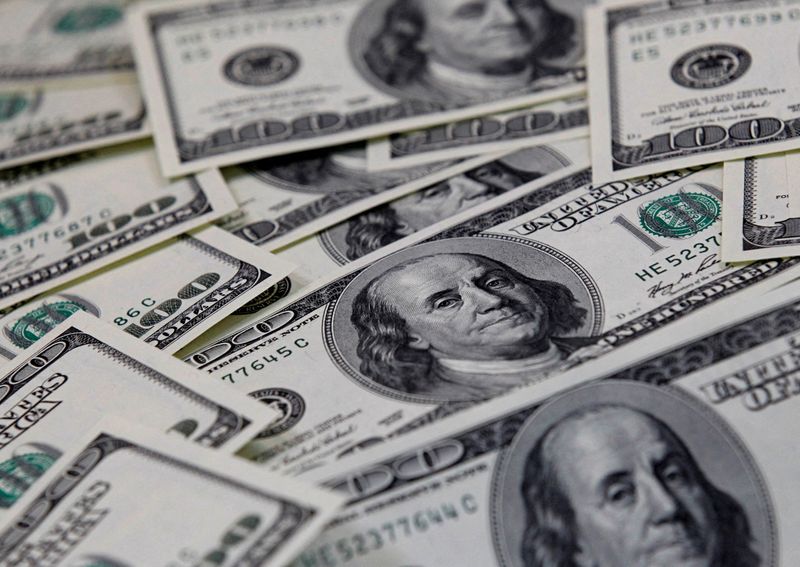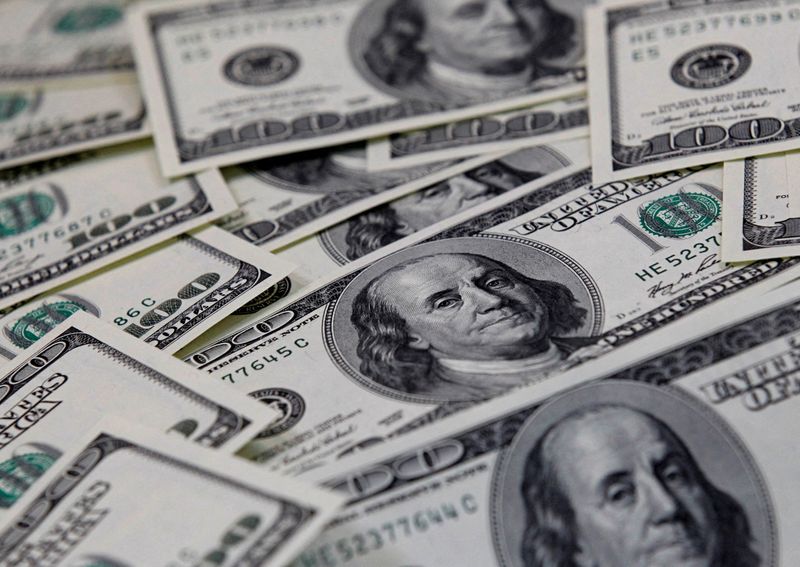Economy
US household debt largely unchanged in Q2, credit card balances jump, NY Fed says


© Reuters. FILE PHOTO: U.S. one hundred dollar notes are seen in this picture illustration taken in Seoul February 7, 2011. REUTERS/Lee Jae-Won/File Photo
By Ann Saphir
(Reuters) – Americans borrowed more than ever on their credit cards in the last quarter, the New York Federal Reserve Bank said on Tuesday, with balances surpassing $1 trillion for the first time even as overall household debt loads were largely unchanged.
Credit card balances rose by $45 billion to $1.03 trillion in the second quarter, the regional Fed bank said in its latest quarterly household debt and credit report, reflecting robust consumer spending as well as higher prices due to inflation, researchers said.
Household debt ticked up 0.1% to $17.06 trillion, as mortgage balances – the biggest portion, and typically the biggest driver, of overall household debt – were largely unchanged.
Meanwhile, credit card delinquencies are at an 11-year high, as measured using a four-quarter average, the data showed.
But the quarter-to-quarter trend appeared less alarming, with New York Fed researchers noting a leveling out near pre-pandemic levels in the most recent two quarters.
“Despite the many headwinds American consumers have faced over the last year – higher interest rates, post-pandemic inflationary pressures, and the recent banking failures – there is little evidence of widespread financial distress for consumers,” New York Fed researchers wrote in a blog accompanying the data release.
Though rising balances will challenge some borrowers, and student loan borrowers may be squeezed as student loan repayments resume this fall, they wrote, “household credit shows some early signs of stabilizing at pre-pandemic health, albeit with higher nominal balances.”
Student loan balances declined by $35 billion to $1.57 trillion in the second quarter, the data showed. New York Fed researchers attributed the decline to the timing of the academic year, as well as to some small forgiveness programs kicking in.
Mortgage originations increased to $393 billion in the April-June period, from a nine-year low of about $324 billion last quarter, the data showed.
They remain much lower than the average in the first two years of the COVID-19 pandemic, reflecting the impact of the U.S. central bank’s aggressive interest rate hikes over the past 15 months. Overall mortgage balances ticked down to $12.01 trillion, from $12.04 trillion in the prior quarter, reflecting some changes in credit reporting that are expected to reverse next quarter, New York Fed researchers said.
Auto loan balances continued their long-term increase, rising by $20 billion to $1.58 trillion in the second quarter, the data showed. Originations rose about 11% to $179 billion, reflecting the sharp rise in car prices; the number of newly opened loans remains below pre-pandemic levels, the report said.
Economy
Russian central bank says it needs months to make sure CPI falling before rate cuts -RBC


© Reuters. Russian Central Bank Governor Elvira Nabiullina attends a news conference in Moscow, Russia June 14, 2019. REUTERS/Shamil Zhumatov/File Photo
MOSCOW (Reuters) – Russia’s central bank will need two to three months to make sure that inflation is steadily declining before taking any decision on interest rate cuts, the bank’s governor Elvira Nabiullina told RBC media on Sunday.
The central bank raised its key interest rate by 100 basis points to 16% earlier in December, hiking for the fifth consecutive meeting in response to stubborn inflation, and suggested that its tightening cycle was nearly over.
Nabiullina said it was not yet clear when exactly the regulator would start cutting rates, however.
“We really need to make sure that inflation is steadily decreasing, that these are not one-off factors that can affect the rate of price growth in a particular month,” she said.
Nabiullina said the bank was taking into account a wide range of indicators but primarily those that “characterize the stability of inflation”.
“This will take two or three months or more – it depends on how much the wide range of indicators that characterize sustainable inflation declines,” she said.
The bank will next convene to set its benchmark rate on Feb. 16.
The governor also said the bank should have started monetary policy tightening earlier than in July, when it embarked on the rate-hiking cycle.
Economy
China identifies second set of projects in $140 billion spending plan


© Reuters. FILE PHOTO: Workers walk past an under-construction area with completed office towers in the background, in Shenzhen’s Qianhai new district, Guangdong province, China August 25, 2023. REUTERS/David Kirton/File Photo
SHANGHAI (Reuters) – China’s top planning body said on Saturday it had identified a second batch of public investment projects, including flood control and disaster relief programmes, under a bond issuance and investment plan announced in October to boost the economy.
With the latest tranche, China has now earmarked more than 800 billion yuan of its 1 trillion yuan ($140 billion) in additional government bond issuance in the fourth quarter, as it focuses on fiscal steps to shore up the flagging economy.
The National Development and Reform Commission (NDRC) said in a statement on Saturday it had identified 9,600 projects with planned investment of more than 560 billion yuan.
China’s economy, the world’s second largest, is struggling to regain its footing post-COVID-19 as policymakers grapple with tepid consumer demand, weak exports, falling foreign investment and a deepening real estate crisis.
The 1 trillion yuan in additional bond issuance will widen China’s 2023 budget deficit ratio to around 3.8 percent from 3 percent, the state-run Xinhua news agency has said.
“Construction of the projects will improve China’s flood control system, emergency response mechanism and disaster relief capabilities, and better protect people’s lives and property, so it is very significant,” the NDRC said.
The agency said it will coordinate with other government bodies to make sure that funds are allocated speedily for investment and that high standards of quality are maintained in project construction.
($1 = 7.1315 renminbi)
Economy
Russian central bank says it needs months to make sure CPI falling before rate cuts -RBC


© Reuters. Russian Central Bank Governor Elvira Nabiullina attends a news conference in Moscow, Russia June 14, 2019. REUTERS/Shamil Zhumatov/File Photo
MOSCOW (Reuters) – Russia’s central bank will need two to three months to make sure that inflation is steadily declining before taking any decision on interest rate cuts, the bank’s governor Elvira Nabiullina told RBC media on Sunday.
The central bank raised its key interest rate by 100 basis points to 16% earlier in December, hiking for the fifth consecutive meeting in response to stubborn inflation, and suggested that its tightening cycle was nearly over.
Nabiullina said it was not yet clear when exactly the regulator would start cutting rates, however.
“We really need to make sure that inflation is steadily decreasing, that these are not one-off factors that can affect the rate of price growth in a particular month,” she said.
Nabiullina said the bank was taking into account a wide range of indicators but primarily those that “characterize the stability of inflation”.
“This will take two or three months or more – it depends on how much the wide range of indicators that characterize sustainable inflation declines,” she said.
The bank will next convene to set its benchmark rate on Feb. 16.
The governor also said the bank should have started monetary policy tightening earlier than in July, when it embarked on the rate-hiking cycle.

 Forex2 years ago
Forex2 years agoForex Today: the dollar is gaining strength amid gloomy sentiment at the start of the Fed’s week

 Forex2 years ago
Forex2 years agoHow is the Australian dollar doing today?

 Forex1 year ago
Forex1 year agoUnbiased review of Pocket Option broker

 Forex2 years ago
Forex2 years agoDollar to pound sterling exchange rate today: Pound plummeted to its lowest since 1985

 Cryptocurrency2 years ago
Cryptocurrency2 years agoWhat happened in the crypto market – current events today

 World2 years ago
World2 years agoWhy are modern video games an art form?

 Stock Markets2 years ago
Stock Markets2 years agoMorgan Stanley: bear market rally to continue

 Economy2 years ago
Economy2 years agoCrude oil tankers double in price due to EU anti-Russian sanctions

































